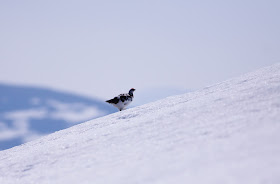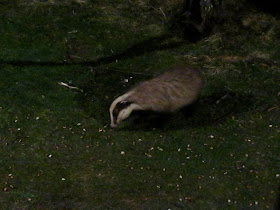With our last day dawning as
sunny as ever, we decided to get up early and head back to the location where
we saw the male Capercaillie the day before in the hope of getting further
sightings of this magnificent Scottish speciality. We were in luck - down the
path just in front of us we spotted a female Capercaillie flying up to the top
of one of the towering pines lining the trail! We enjoyed great views of her
beautiful chestnut coloured plumage and richly patterned feathers before she
became completely invisible and out of sight at the top of the tree.
Interestingly we encountered
masses of Capercaillie poo in the area mainly along the sides of ridges and
trails, indicating that the birds may choose to follow these indents in the
substrate as natural pathways.
It’s amazing to think of these
huge birds roaming through the landscape and it’s especially sad that they are
now becoming a rare sight in their last stronghold of the Scottish forests,
mainly due to disturbance, habitat fragmentation and habitat loss. It was great
to have seen both a male and female on our trip, and it was a perfect end to
our visit to these ancient Scottish forests.
Still relatively early in the
day and our target species achieved, we decided to head north to Lochindorb to
see if we could locate the divers that breed on the huge expanse of water.
Driving down to the loch, the surrounding heather next to the road was full of
Red Grouse, the birds allowing a fantastically close approach using the car as
a hide. Normally used to distant individuals flying away in the Derbyshire peak
of the Goyt Valley, I made the most of this excellent photographic opportunity
to get some pictures.
 |
| Caper poo! |
 |
| The squirrel from the previous day was still about! |
Arriving at the loch, we
scanned the choppy waters for any signs of the divers, and eventually Alex
managed to pick out the pair distantly on the other side of the bank. Assuming
they were Black-throated, we had second thoughts as the pair approached closer,
the sides of the head looking just too solidly grey, more similar to the
markings of Red-throated Divers.
We moved round for a better angle, and eventually as they drifted closer I could make out the red tint to the throat underneath and the smooth pale grey sides to the head and neck – two cracking summer plumaged Red-throated Divers.
We moved round for a better angle, and eventually as they drifted closer I could make out the red tint to the throat underneath and the smooth pale grey sides to the head and neck – two cracking summer plumaged Red-throated Divers.
Enjoying a nice lunch by the
side of the loch, we headed further north to try and catch up with any Hooded
Crows, not having seen any on our journey so far. Approaching Inverness, we
encountered various hybrid Hooded x Carrion Crows, slightly too dark and
blotchy to be considered pure. Hooded Crows can usually be found North and West
of the line splitting Inverness, so we travelled westward to visit the famous
Loch Ness, with hopes of finding more than a Hoodie at the back of my mind.
Thankfully after stopping next
to one of the ploughed fields which held an absolute abundance of corvids, we
tracked down two pure birds, easily identifiable by their light grey shawls and
darker heads. Quite underrated, these birds are subtly beautiful, and it was
great to see them just on the very outskirts of their natural range.
 |
| One of the hybrid Hooded x Carrion crows |
Unfortunately Loch Ness drew a
blank in the search for any lurking mythical sea creatures….
With time pressing on we made our way back down to the fantastic B&B in Cumbernauld from a couple of nights earlier as a stopover point before our trip back to the North West the next day, and we enjoyed our second meal at the delicious Beefeater nearby – a fantastic end to what was a truly brilliant and memorable minibreak.
With time pressing on we made our way back down to the fantastic B&B in Cumbernauld from a couple of nights earlier as a stopover point before our trip back to the North West the next day, and we enjoyed our second meal at the delicious Beefeater nearby – a fantastic end to what was a truly brilliant and memorable minibreak.
With such Scottish treasures
as Capercaille, Ptarmigan, Crested Tit, Pine Marten and summer plumaged Red-throated
Divers under our belt, and all our targets for the trip achieved, I’m now
looking forward to our next journey north of the border to track down Scottish
Crossbills and hopefully to take a trip on the boat at Portsoy to get views of
the regular White-billed Divers that frequent those waters. Massive thanks to
Alex for doing all the driving - a fantastic trip and most definitely well
worth the effort!
 |
| The bridge Carrbridge is named after! |














































